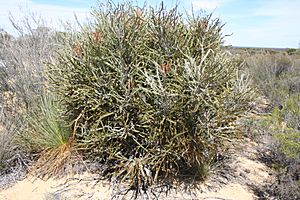Swordfish banksia
Quick facts for kids Swordfish banksia |
|
|---|---|
 |
|
| Near Yellowdine | |
| Scientific classification | |
| Genus: |
Banksia
|
| Species: |
elderiana
|
The Swordfish Banksia (Banksia elderiana) is a cool shrub that belongs to the Banksia family. It's a bushy plant with stiff, jagged leaves and bright yellow flowers that grow in spikes. You can find it in two different areas of the Goldfields-Esperance region of Western Australia. One area is west of Kalgoorlie and goes south to Ravensthorpe. The other area is in the Great Victoria Desert, north of the Queen Victoria Spring.
Contents
What Does the Swordfish Banksia Look Like?
The Swordfish Banksia grows as a tangled, bushy shrub. It can reach up to 3 meters (10 feet) tall. When new parts of the plant grow, they are covered in soft brown fur.
Leaves and Flowers
The leaves of this plant are long, stiff, and narrow. They can be 15 to 40 centimeters (6–16 inches) long and 1.2–2 centimeters (0.5-0.8 inches) wide. The edges of the leaves have many sharp teeth, like a saw. This is why it's called the "swordfish banksia"!
The plant usually flowers between January and March, but sometimes it keeps flowering into winter. Its flowers are all yellow and hang down from the branches. These flower spikes are about 4–6 centimeters (1.6–2.4 inches) long.
Seed Pods
As the flowers get older, they turn grey. Up to 30 large, woody seed pods, called follicles, grow where the flowers used to be. These pods are oval-shaped and covered with fine hair. They can be up to 2.5 centimeters long, 1.4 centimeters high, and 1.8 centimeters wide.
How Was the Swordfish Banksia Discovered?
The first time Banksia elderiana was collected was on September 17, 1891. This happened during the Elder Exploring Expedition. A naturalist named Richard Helms found it about 130 kilometers (80 miles) northeast of Queen Victoria Spring in the Great Victoria Desert.
Naming the Plant
Two scientists, Ferdinand von Mueller and Ralph Tate, officially described the plant in 1893. They published their findings in a science journal. They named the plant elderiana to honor Sir Thomas Elder, who paid for the expedition where the plant was found.
Where Does the Swordfish Banksia Grow?
The Swordfish Banksia lives in two separate areas. The main area is a large region between Hyden in the west and Salmon Gums (west of Kalgoorlie) in the east. The other area is northeast of Queen Victoria Spring in the Great Victoria Desert, which is east of Kalgoorlie.
The two groups of plants don't connect because the soil around Kalgoorlie is too heavy for them to grow there. This plant prefers to grow in yellow sandy soils. You can find it in areas with mallee woodlands, dry shrublands, and grasslands.
How Does the Swordfish Banksia Survive Fires?
The Swordfish Banksia has a special woody base called a lignotuber. This lignotuber helps the plant survive bushfires. After a fire, new shoots can grow from this base, allowing the plant to come back to life.
This banksia is also quite strong against a plant disease called dieback. Dieback is caused by a type of water mold called Phytophthora cinnamomi. Many other banksia plants in Western Australia are very easily affected by this disease, but the Swordfish Banksia is not as vulnerable.
Growing Swordfish Banksia in Gardens
People don't often grow the Swordfish Banksia in their gardens. However, it does well in dry climates. It can also handle cooler areas, but it doesn't like places that are too humid or wet.
This plant likes soil that is slightly acidic to neutral (a pH of 6.0 to 7.0) and needs a sunny spot to grow. If you prune it, you can keep it from becoming too messy as it gets older. Its tangled branches are great for small birds, giving them shelter and places to build nests.
If you want to grow it from seeds, you don't need to do anything special to the seeds. They usually take about 31 to 42 days to sprout.
Images for kids


